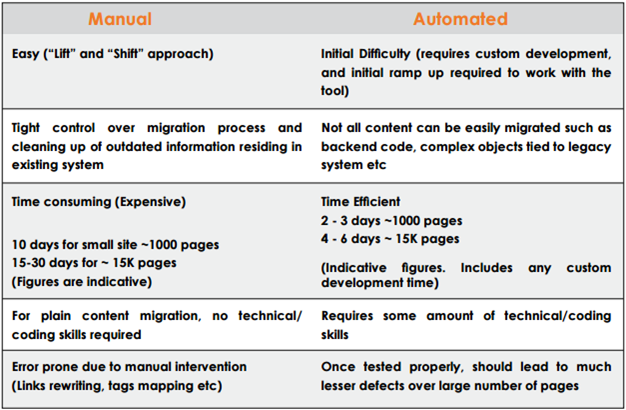Basics of Content Migration: Manual and Automated
If you are planning to upgrade / change your CMS / framework, content migration is one of the crucial things that need to be planned.
Content migration is not a single person job, as it would become extremely intricate if your site has a lot of content, not just text, but images and other graphics. When you decide to redesign your website, you wouldn’t be paying much attention to the content part, but only the design and the user experience associated with it. Migration of content can become more complex, the more the newer design deviates from your original design.
There can be two ways managing content migration viz manual or automated. Either you dedicate a team of content creators to generate and migrate all your content newly generated to the newly designed website. Or, make use of automated tools and methodologies to make the whole process of migration seamless.
Not always the manual mode of content migration is erroneous. Rather, it depends upon the volume of data that needs to be migrated and the environments between which the content is swapped.
Here are some of the best practices for Content Migration:
As a preliminary step you should try and answer the following questions:
- How many number of websites needs to be migrated?
- How many pages of content need to be migrated?
- How organized is the structure of the content? How does it affect the new website layout?
- Does your existing environment offer you features to export the content? What are the steps involved and how complex is the process?
- Does your destination help you easily import your data?
- Have a qualitative and quantitative analysis been performed on the content manually?
When the number of pages to be migrated is lesser than 1000, you may stick with manual process of migration by hiring an external agency or managing it in-house. Anyhow, it is also dependent on the complexity of the architecture and environments involved.
On the other hand, if you prefer to use automated tools to migrate the content, you need to come up with custom scripts developed in-house, or hire an external agency to do the same for you. Developing custom scripts would require a considerable amount of effort and time of your development team. It’s not going to be as easy as you think.
There are many content migration projects that are practically feasible only through automation. Setting up the automation process can be cumbersome in the beginning, but once if you are all set to run, it can save a lot of your time and efforts.
The differences between manual and automated content migration are listed below in the table:

Differences between manual and automatic content migration
Moreover, the automated migration process can be expensive due to the cost or the licensing of certain tools.
Any automated migration process can be divided into three phases:
- Extract
- Transform and
- Load
The three phases combined together can be called a ETL cycle. As the names suggest, a ETL cycle extracts the data from the source and transform into a format that is compatible with the destination and load the data after transformation. Talend is a tool that can help you in extracting, transforming and loading content. There is also a step called post-migration clean-up that involves tags mapping and URL mapping.
The entire process of automated content migration would require some coding skills required to realise the whole project effectively.
No matter whether you prefer manual or automated migration, some amount of human analysis is always required to make the transition. In either of the methods, meticulous planning will make the redevelopment of your website more easy.



